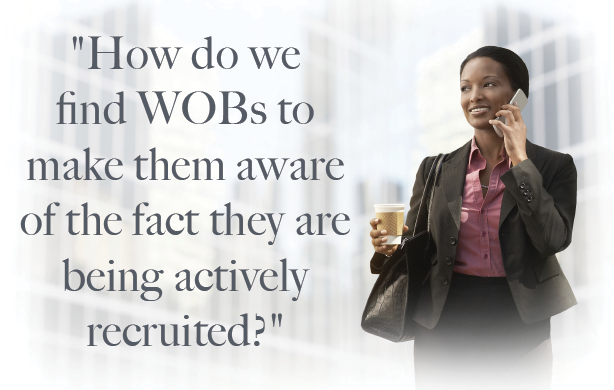 The state of gender equality remains dismal in the United States, as it always has been. From Fortune 500 boardrooms to poverty levels, gender imbalances touch and impact all aspects of women’s lives. It has been almost 30 years since women could get business loans without a male cosigner and yet, a majority of women continue to lack awareness of special programs and designations for which we have worked so hard to develop and implement to increase diversity spend for women.
The state of gender equality remains dismal in the United States, as it always has been. From Fortune 500 boardrooms to poverty levels, gender imbalances touch and impact all aspects of women’s lives. It has been almost 30 years since women could get business loans without a male cosigner and yet, a majority of women continue to lack awareness of special programs and designations for which we have worked so hard to develop and implement to increase diversity spend for women.
In 2016, we are finally seeing conversation around core business practices and corporate social responsibility towards women. C-suite women and women-owned businesses working in the housing ecosystem—consisting of several real estate related industries within retail, residential, industrial and commercial sectors—have been underutilized and underrepresented.
For decades, women have lacked a seat at the table. This needs to be brought to the forefront and not simply spoken about behind closed doors. Given how hard and long women have invested to get where they are today, many are fearful of the repercussions associated with voicing their concerns about these inequalities. Bottom line, women are not afforded equal C-suite opportunities and several staffing companies still utilize rolodexes with the same people for decades. We need to introduce fresh, diverse talent into these executive offices and boardrooms.
In the same vein, with increased numbers of females in upper management, women have role models and sponsors to help them through the ranks. Having the opportunity to see, hear, and shake the hand of another successful woman instills confidence and belief in young entrepreneurs.
New young female professionals are a great asset, as women in housing are not getting any younger. We need to recruit millennials and Generation Z to bring the added diversity of younger generations to the women’s movement. With this diversity of talent and foresight, companies will see their bottom line profits and impact climb.
Regarding women-owned businesses (WOBs), the federal government has no internal tracking system to date. Independent third parties simply supply the record keeping and the old saying, “Garbage in, Garbage out!” There is not one site or resource center for women-owned firms. Many of these businesses are not registered and don’t know the value add of certifying as a WOB. How can you effectively increase women’s diverse spend including the number of WOBs, if companies can’t find these businesses or even know they exist?
Companies that have develop-
ed businesses practices centered on supporting and incorporating women are actively seeking out WOBs. Unfortunately, in several sectors, finding a WOB in housing is like finding a needle in a haystack.
With the Federal Housing Finance Agency’s (FHFA) new Office of Minority and Women Inclusion (OMWI) Strategic Plan giving a report card to Fannie Mae and Freddie Mac on their diverse spend and outreach efforts, entities doing business with these government-sponsored enterprises (GSE) are beginning to see the added value of increasing their own diverse spend. It not only helps serve local communities, it also raises their bottom-line profits. Utilizing WOBs is a win-win situation.

How do we find WOBs to make them aware of the fact they are being actively recruited?
We must start at the basics; develop a Women’s Global Resource Center. Create a simple platform for women to not be fearful and understand the value of capitalizing on the opportunities at their disposal.
Contact the women’s groups, government agencies, trade associations, embassies, publicly and privately-held companies and anyone that can contribute to uniting women with prospective clients. Make it quick and simple so time isn’t a factor. Make it free, so cost isn’t a factor. Make it global and available in dozens of languages to spread the culture.
The National Association of Women in Real Estate Businesses (NAWRB) has done just that!
The NAWRB Women’s Global Resource Center provides a women’s depository for vendors and clients to grow their diverse spend and increase women’s employment at all levels. NAWRB’s goal is to have 250,000 women registered by 2018.
How do entities find women in the housing ecosystem and associated women-owned businesses? What is the best outlet to locate a women-owned business? There isn’t a clear answer.
NAWRB Founder and CEO Desirée Patno states, “There are opportunities for women and women-owned businesses that aren’t being utilized to their full potential. Set-asides are therefore limited and not being fulfilled, as entities cannot always find women-owned businesses to award contracts for their diverse spend. In addition, there are too few C-suite women in our industry seated at the table and available for mentorship or sponsorship.
The mission of the NAWRB Women’s Global Resource Center is connecting women of all levels and women-owned businesses within the housing ecosystem to pivotal business opportunities. Ownership or women-owned business certification, while a requirement for government contracts, isn’t mandatory for opportunities in the private sector or to enroll in our resource center. By creating a depository of women business professionals and women-owned businesses, NAWRB is bringing more women business avenues to the forefront.”

 Login
Login
